News
Dec 31, 2018
November and December proved to be two great months for my photography. The fall and early winter offered up some wonderful subjects from White-tailed Deer to migrating waterfowl and the early arrival of "winter finch" species. I got to photograph an uncommon Red-Necked Grebe as well as Common Loons, Snow Geese, Common Mergansers and others
November is the time for the White-Tailed deer rut. Bucks are not often seen during much of the year but breeding season has them out strutting their stuff as they search for a mate. I was able to photograph several impressive males in the cold and snow. On one occasion I also got created some images of a normally secretive coyote as well.
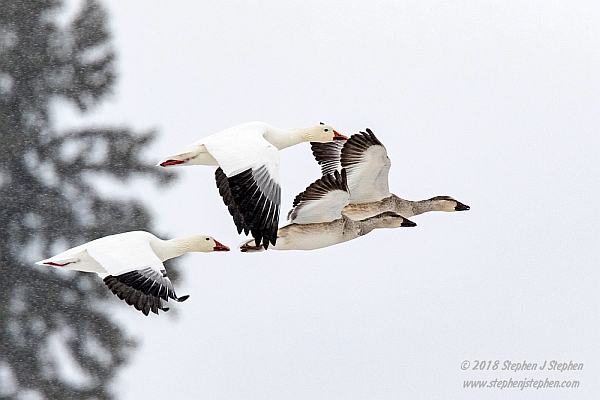
Many Boreal birds, commonly referred to as "Winter Finches", are only seen occasionally around Ottawa. So far this winter we have been treated to the appearance a good numbers of both Pine and Evening Grosbeaks. The males of both species are striking in colour. Pine Grosbeak males are rosey red while Evening males have bright yellow and rusty browns. If all goes well there will be more opportunities to photograph these handsome species over the coming months
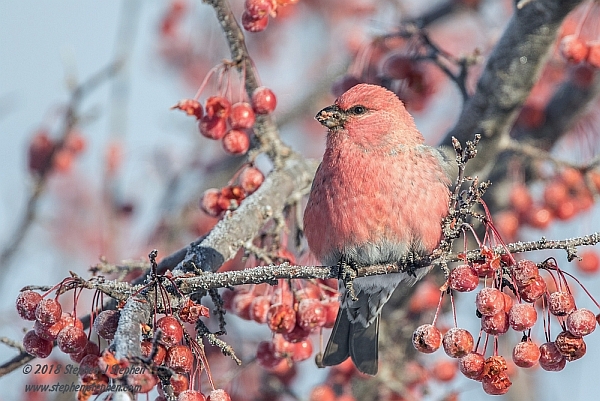
You can view more of my November and December 2018 images by clicking here.
Oct 31, 2018
Summer and early autumn were very busy times for us. We camped at two provincial parks in eastern Ontario including, for the first time, Lake St. Peter Provincial Park south of Algonquin. It was a lovely little park and while it did not offer a lot in the way of wildlife photo opportunities we enjoyed our time there. I did get to photograph a family of Common Mergansers which visited the park's swimming beach very early on several mornings as they juveniles and their mother searched for their breakfast.
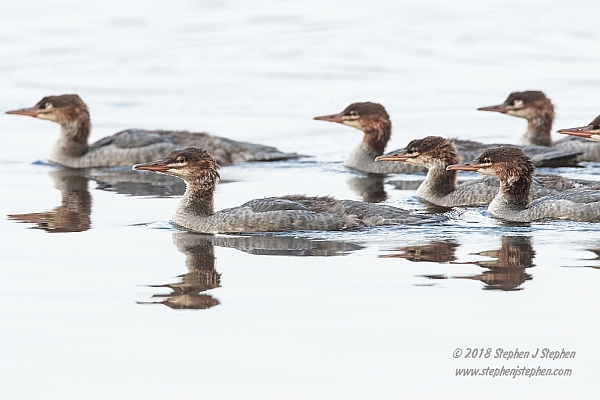
Unfortunately our 10 day camping trip to Algonquin Provincial Park scheduled for early October had to be cancelled. Our home, and much of Ottawa, lost electrical power for many days due to several tornados that struck our neighbourhood and several others. We were extremely lucky to have the tornado miss our street by about 500 meters. Many people in the surrounding neighbourbood, were not so fortunate, and they suffered extensive damage to their homes. We did make a short day trip to Algonquin while at Lake St. Peter Provincial Park.
Even though our Algonquin trip was cancelled we enjoyed time around Ottawa. A leucistic Black-capped Chickadee visited our backyard feeders throughour September and October. Leucism is a condition in animals where there is a partial loss of pigment in skin, fur, feathers of scales but not the eyes.
I was also able to photograph some migratory birds such Black Brant geese. Brant are very small geese about teh size of a Mallard Duck. Their colouring resembles that of a Canada Goose but can easily be distinguished by their much smaller size
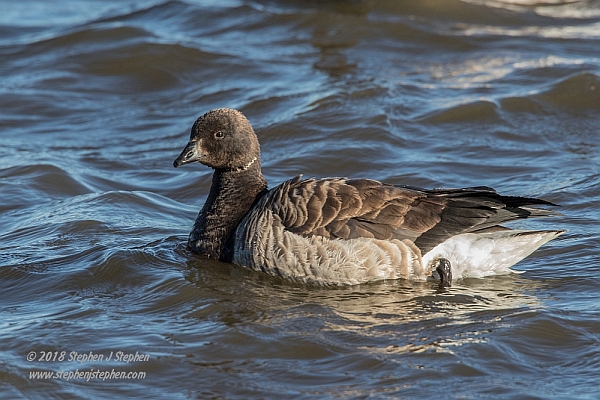
You can view more of my August to October 2018 images by clicking here.
July 31, 2018
While spring often offers many great photo opportunities, especially for migrating birds, summertime can sometimes be a bit slower unless you put in time exploring. This summer was great on many counts. I broadened my list of subjects to include more flowers and insects. That being said, one of the first animals that I photographed in June was a Marbled Godwit. Marbled Godwits (below) are large shorebirds that normally breed on the prairies as well as along James Bay. This bird was off of its normal migration path and entertained both birders and photographers for a few days before moving on.
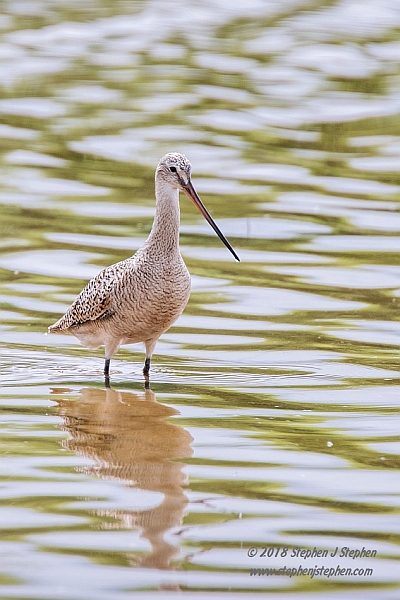
A quick trip back to New Brunswick to visit family, in July, gave me a chance to photograph some seashore scenes and wildlife when I went picking periwinkles with my brother at Maces Bay on the Bay of Fundy. Periwinkles are edible marine snails that many Maritimers harvest for personal consumption. I have fond memories of picking them by hand, with our extended family, as the tide receded on algae-covered rocky shores. We would then have a "boil up" on the beach and sit contentedly eating the salty treats with a straight pin.
While harveting the periwinkles I also photographed some Dogwhelks (a.k.a. Dogwinkles) laying eggs on the rocks. Periwinkles eat algae but Dogwhelks are carnivorous feeding on barnacles, mussels and other mareine species. Like other predatory snail species, dogwhelks use their toothed tongue (radula) to drill holes in the protective shells of their prey. I also created a few landscape images while there despite the foggy day.
After returning to Ottawa I took out my macro lens on a few outings to photograph some widlflowers and insects. It is always interesting to try and present common wild flowers like clover and daisies in a different prespective. I again photographed the talented First Nations dancers at the Summer Solstice Indigenous Festival in Ottawa. I love the beauty of their dances and the creativity they have in making their reglia.
July was spent photographing more birds, flowers and insects. I was excited to be able to create images of both the American Bittern and the Least Bittern (below) two normally shy species that live in marshes.
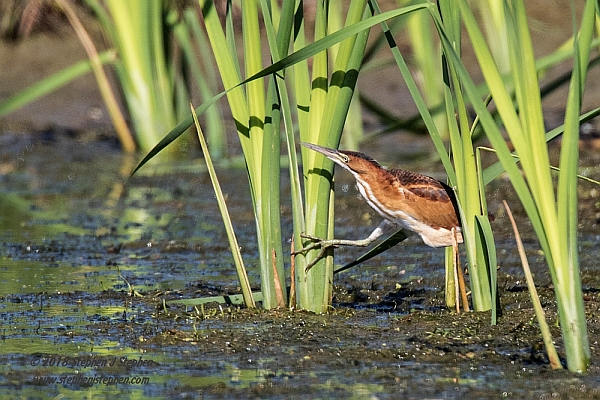
All in all it was an enjoyable summer. You can view a page of my summer 2018 images by clicking here.
May 31, 2018
May brought an exciting time for me. First I have the priviledge to photograph a Red Fox kit that was about 11-12 weeks old. I had been hoping to find for several years. I spent a short but enjoyable time with the very photogenic youngster (see below).
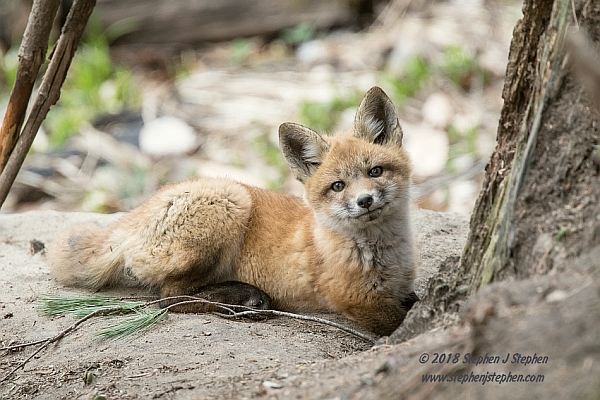
From Vancouver I travelled, with friends into the southern interior of the province in the areas around the town of Merritt and the Douglas Lake Cattle Company (commonly called the Douglas Lake Ranch). Both places are in the Nicola Valley which is about 270 kilometers from Vancouver.
It was my first time to the interior and I found the landscape very different there than the coast. The interior habitat supports a number of species that I had never seen and I was pleased to be able to photograph some of them for the very first time. A stop at the summit of the Coquihalla Highway before reaching Merritt yielding my first Columbia Ground Squirrels. Then it was onto Merrit and Douglas Lake Ranch. The Nicola Valley is cattle country and the Douglas Lake Ranch is likely the largest working cattle ranch in Canada. The ranch was established in 1884 and has been in continuous operation since then. The ranch is enormous with over 270,000 acres directly owned and another 1,000,000 of crown land in use!
I found another life list addition shortly after arriving. A Western Meadowlark was perched on a fence post singing away. Later on we found beautiful Mountain Bluebirds. While I had photographed a wayward female Mountain Bluebird several winters ago near Ottawa, I had never seen the spectacular males before. What a treat! Other life list additions included Yellow-headed Blackbird and the Swainson's Hawk.
After two days in the interior I headed over to Vancouver Island, on an evening ferry ride, for the rest of my adventure. The weather was exceptional and the sunset viewed from the ferry was spectacular. The next day I spent some time photographing waterfalls in Little Qualicum Falls (below) and Englishmans Falls Provincial Parks. Both parks are near Parksville on the east coast of the Island.
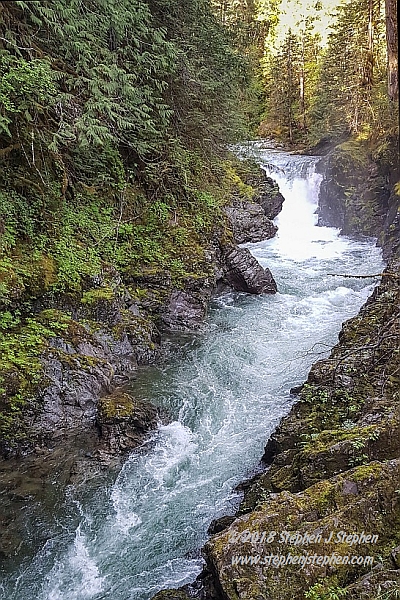
As usual Vancouver Island was a pleasure and I have many wonderful memories of the visit. You can view two pages of my May 2018 images by clicking here.
Mar 31, 2018
March bought me opportunities to photograph both traditional Canadian winter bird subjects as well as some more southern species while on a week-long trip to the Orlando area of Florida.
Each winter I try and make at least one trip to Amherst Island on Lake Ontario. The island is located west of Kingtson and is several hours drive from Ottawa. It is usually a great place to find winter birds, particularly various raptors (owls, hawks & eagles) as well as other species on occasion. During our daytrip there we saw over 10 Snowy Owls, several Long-eared Owls, Rough-legged and Red-tailed Hawks and a special treat for me, a male Northern Harrier.
The male Northern Harrier (see below) is also known as the Grey Ghost due to its destinctive grey colouration. Females are more brown in colouration. While I had seen Northern Harriers a number of times before, I never really had any good images of them particularly of the strking male. It was therefore an exciting discovery to find a male Harrier actively hunting near the end of the afternoon. Harriers primarily hunt over open fields looking for mice, one of their favourite prey species. They often glide low over the fields as they scan the ground below them. I watched this male exhibit some interesting behaviour that I had never seen before. Several times it landed on the ground and shortly afterwards took off again with a 'ball'of grass in its talons. After rising a few feet it would drop the grass. I then realised that the "balls" were mouse nests and it was likely hoping that some of these might have adult or young mice or perhaps both. In any event it was a pleasure watching this agile flying hunter in its preferred habitat.
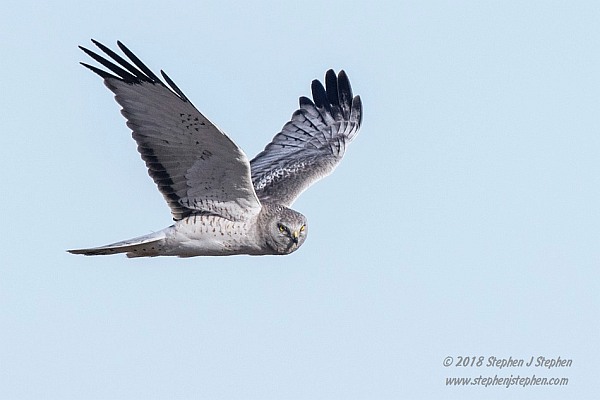
My trip to Florida was primarily to enjoy a family vacation but I had planned to spend at least a good part of one day doing some nature photography. If you have ever been to Florida you will know that it can be a birders and bird photographers' paradise. Many species in Florida have started breeding season by March due to the beautiful, warm weather. With this in mind, and with my limited time to create some images, I elected to visit Gatorland in Orlando. While Gatorland is a well-known local tourist destination featuring Alligators, Crocodiles and snakes the ponds and vegetation have led to many species of wild birds making the location an avian breeding colony/rookery.
Birders and nature photographers can get into the grounds early to observe and photograph the birds in the early morning light and before the crowds arrive. While early entrants are only allowed access to a specific area of the park that area is fantastic for viewing many of the birds up close. The area includes a long boardwalk that mianders over a large alligator pond around which most of the birds are found. Many of the species that breed there are wading birds such as Wood Storks, Herons (Great Blue, Little Blue and Tricloured) as well as Egrets (Great, Cattle and Snowy). There were other species there too including: White Ibis, Double-crested Cormorants, Black Vultures and others. Because it was the breeding season most the birds were resplendent in their full breeding colours and plumage like the Great Egret below.
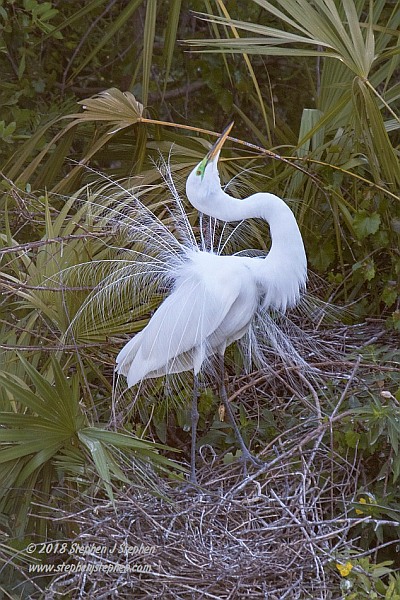
The birds at Gatorland see people daily so they do not appear to show any fear of humans unlike most of the birds that I photograph in Canada. I was able to observe the rookery birds displaying for mates, flying and collecting nest materials, nest building and raising their young. The raised boardwalk afforded me eye level views of much of the activity.
You can view more of my March 2018 images by clicking here.
Jan 31, 2018
While I did not get out often in January it proved to be a rewarding month photography-wise. Trips to both Gatineau Park in Québec and a long day-trip to Algonquin Provincial Park, Ontario provided great bird phtography opportunities.
In particular, I was able to photograph both Wing-Winged and Red Crossbill finches. In both species their bills have evolved to a unique shape where the upper and lower bills are permanently crossed. This permits them to easily pry apart the scales of conifer cones, The birds then use their tongues to extract the seeds hidden inside. During years when mature cone crops are abundent both species can, at times, begin nesting in late December or early Janaury.
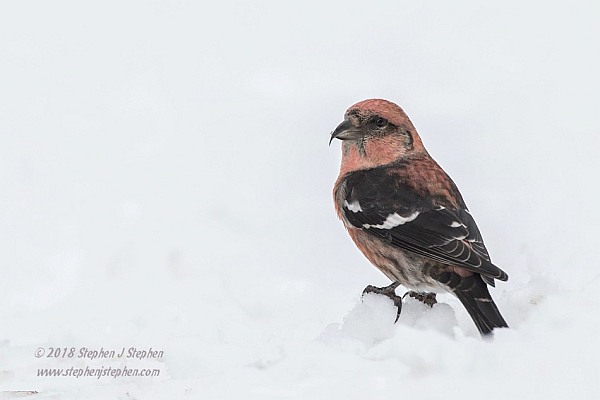
Snowy Owls returned to the Ottawa area as did other winter species. Another very exciting discovery was a small group of Short-Eared Owls that remained in an area of west Québec up river from Alymer, Québec for several weeks.
Short-eared Owls often begin hunting near dusk but ocassionally they do hunt in the daytime flying low over open fields. This group frequently began hunting in mid to late afternoon affording viewers excellent opportunities to see their hunting behaviour as they searched for mice in far fields. Several times I watched them as the hovered over the snow looking for the slightly movement. Suddenly one would dive down into ths snow to catch a meal.
If an owl caught a mouse it would often, like many raptors do, exhibit mantling behaviour. Mantling often involves hunching and spreading wings over a recent kill. They do this to protect their prey from other birds and predators who might possibly steal their food. The owl would often look around for a minute or so before taking off with its meal and flying to s perch where it could eat in peace.
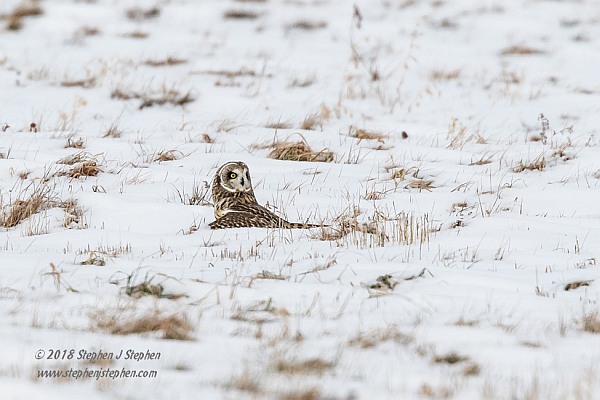
While I have been fortunate enough to photograph most of the owl species that live in Ontario I had never before had so many great chances to observe and photograph the behaviour of Short-Eared Owls. Watching these wonderful aerial hunters when they were not harassed or otherwise interfered with during their normal hunting behaviour was a great treat.
You can view more of my winter images by clicking here.
Dec 31, 2017
November and December offered a variety of interesting subjects. Two unusual avian visitors entertained both birders and photographers for several weeks. A beautiful Black-throated Gray Warbler thrilled people for weeks in November and early December. Black-throated Grays are normally only found west of the Rocky Mountains so this individual was way off course for its fall migration. It was only the second time that this species had been seen in the greater Ottawa area. The second species was a Nashville Warbler. The Nashville Warbler is a much more regular visitor around Ottawa during spring and fall migrations but this late individual offered a bit of colour during a time that can normally be somewhat laking in colour and interest.
Other migrants included Sandhill Cranes, Golden-crowned Kinglets and several species of waterfowl. I like to compare Kinglets bouncing ping ping balls. These little insect eating birds seem to be oalmost constantly on the move hunting in the tree branches for food.
I was also fortunate enough to photograph a River Otter fishing for nearly an hour late one afternoon. Although it was fishing far off in the lake I managed to create a few interesting images.
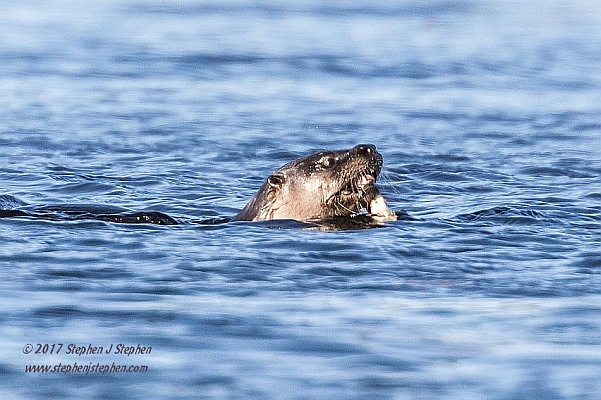
In early December my wife and I travelled to the Kitchener and Hamilton areas of southern Ontario to visit family and to take in some of the interesting markets in those areas. We visited the St. Jacob's Fand Kitcherner markets and well as the annual Kitchener Kristkindl market. All of these markets offer great photo opportunities.
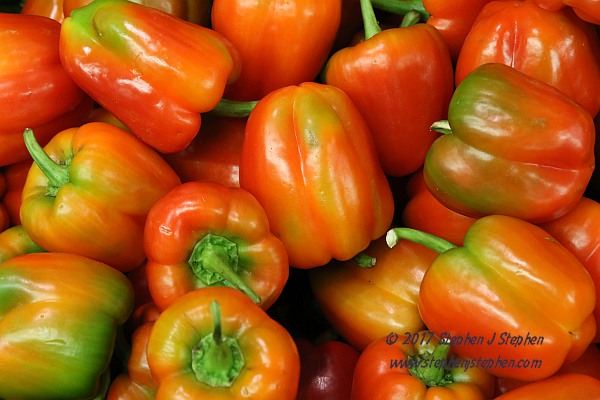
Before heading back home to Ottawa we made our first visit to the Toronto Zoo. I've seen some amazing images from some talented photographers created in a zoo or safari park setting. That being said it's not a style of photography that I am personally interested in doing very often. on that morning we were some of the first people through the gates that very cold morning. That gave us time to be able to spend a few quite minutes alone with 3 of the Panda Bears on loan from the People's Republic of China just as they were having their first bamboo meal of the day.
These interesting looking animals seem to be made for the camera. Despite having to shoot through glass I managed to create a few images that I was happy with. This particular shot I feel is my best from that visit.
You can view more of my late fall and early winter images by clicking here.
Oct 30, 2017
My September started off with a visit to MosaïCanada 150 in Gatineau, Québec as part of Canada's 150th birthday celebrations. MosaïCanada 150 was described as largest horticultural event in Canada. It featured phenomenal "living' sculptures constructed out of plants and flowers. These massive sculptures represented historical and cultural representations from all parts of Canada's provinces and territories
September also had an unusual increase in numbers of Painted Lady Butterflies across much of eastern and southern Ontario. Fortunately for me I was able to photograph a number of these beauties in my area before they moved on
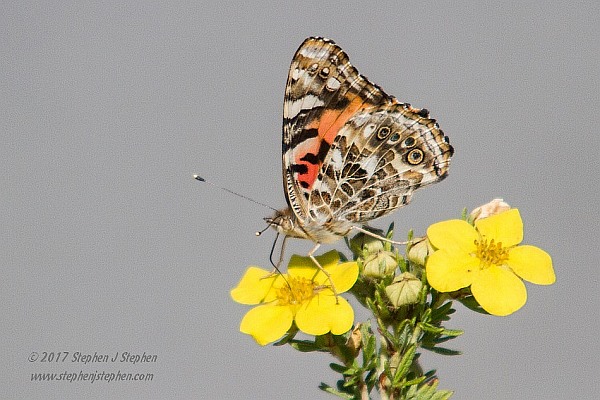
September and October were also similar and yet different than the same time period in 2016. Both Green Herons and Great Egrets were again photographic subjects in Ottawa. On the other hand the wildlife like moose in Algonquin Provincial Park were less apparent. Part of the reason may have been the ongoing road construction along the highway 60 corridor through the park. Despite the lack of visible wildlife subjects during the day, I was able to make multiple short recordings of Eastern Wolves howling at night near our campground. It is amazing to hear these haunting sounds of the wild while sitting around your campfire.
You can hear a compilation audio of the wolves howling, with accompanying images taken in the park over several years, by clicking here.
We ended October with an evening trip to Upper Canada Village near Cornwall, Ontario. During the summer the village hires people to reenact life in Ontario from the late 1880s. We were there for their Halloween display called Pumpkin Inferno. While there I did create a few images of some of the old buildings. I will definitely be going back again in teh summer to see the reenactment activities.
You can view more of my fall 2017 images by clicking here.
Aug 31, 2017
The summer of 2017 saw us traveling around Ontario and enjoying it's many sights and celebrations' I photographed both Yellow and Showy Lady Slipper wild orchids in eastern Ontarioa. We camp along the Ottawa river in Voyageur Provincial Park and traveled to southern Ontario to see the Tall Ships in Hamilton and watch Canada Day Fireworks from a boat beneath Niagara Falls. While in Hamilton I took a short morning trip to see a Dicksissel (see image), a bird most commonly breeds in midwestern North America. This year however a number of these birds arrived in southern Ontario and even bred in several locations. Seeing this bird added another species to my life list.
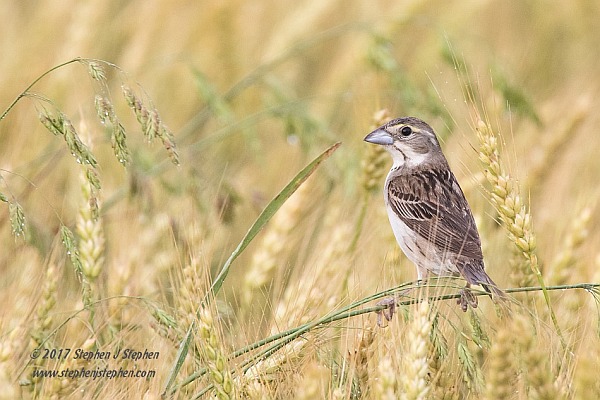
In June we attended the Summer Solstice Indigenous Festival in Ottawa. It is always a great opportunity to watch talented indigenous dancers compete in their incredible regalia.
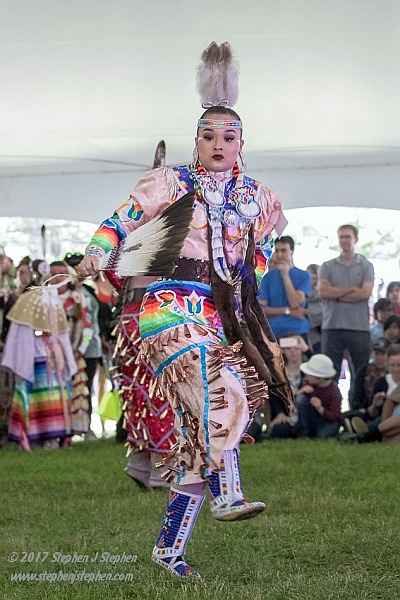
I also traveled back to New Brunswick with our son to spend a few days with my father, my 2 brothers and a brother-in-law. We were at my brother's salmon camp on the southwest Miramichi River. The area is well known for great salmon fly-fishing but dry weather kept migrating salmon scarce. It was still a very enjoyable time none the less.
To more images from the summer of 2017 please click here.
May 31, 2017
"Spring Migration 2017!"
I again was fortunate to spend 2 weeks in southern Ontario during the 2017 spring bird migration. As in 2014, the bulk of my time was spent in Point Pelee National Park, Wheatley and Rondeau Provincial Parks and surrounding areas. This time however I also had the opportunity to spend several days at Long Point and the nearby locations for the first time. Both Point Pelee and Long Point offered some great sightings of birds, animals, plants and scenery. As usual the park staff, Friends of Point Pelee volunteers, birders and photographers at Point Pelee were all wonderful and very helpful. Their enthusiasm for nature, particularly birds, was infectious!
I was better prepared this time when visiting Point Pelee for the Festival of Birds 2017 Edition. As a photographer, you often use long lenses, tripods and other heavy camera equipment, so it's not as easy to 'chase' rare bird sightings. I decided to spend more time trying to create better images of whatever bird species I encountered. With very few exceptions I stuck with my plan and it worked out very well for me. I got some lovely images of a number of species that I had seen in 2014 particularly the stunning Prothonotary Warbler (below). In addition I saw several new life list species including the Kirkland's and Gold-Winged Warblers, Yellow-Throated Vireo and the Eastern Fox Snake.
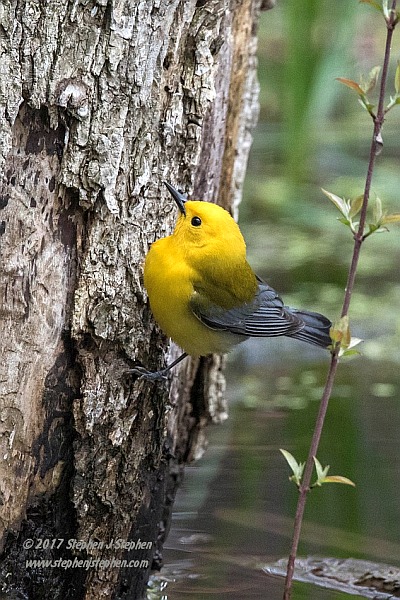
The areas around Long Point had their own rewards. I got my first images of a female Eastern Towhee, saw my first Sandhill Crane colt albeit from a great distance. I also discovered the largest collection of White Trilliums (below) that I had ever seen while visiting Backus Woods.
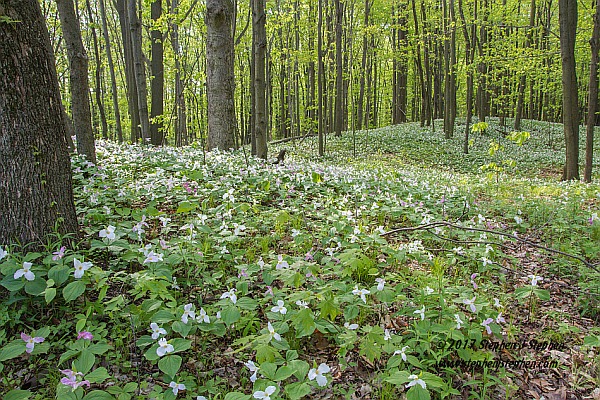
I also visited the Long Point Bird Observatory and its Old Cut Research Station. The station is open the the public and you can observe bird banding first hand as the workers examine, band and record information each bird caught in their mist nets. If you are in the area during spring or fall migration, it's certainly worthwhile to visit the station
You can view more of my Spring Migration 2017 images by clicking here.
Apr 30, 2017
March and April are challenging times for nature photography around Ottawa. The daylight is still short, although getting longer, and snow continues to linger. It is still cold most days and a long way from when wild flowers will start blooming. Days often seem grey and gloomy. That being said there are still opportunities to capture nice images. Waterfowl often have begun their northward migration and stop where there is open water and places like farm fields to forage in.
I was able to create images of a number of species of ducks and geese including: Snow and Canada geese, Bufflehead, Ring-Necked and Lesser Scaup ducks. Some of the early migrating sparrow species put in an appearance as well. White-Throated, Song and White-Crowned Sparrows all visited our yard and feeders. I captured images of Northern Flickers, one of our woodpecker species, and some of our overwintering species such as White-Breasted Nuthatches and Northern Cardinals along some of Ottawa`s many nature areas. The first male Red-Winged Blackbirds arrived in April. The males arrive ahead of the females so that they can stake out the best territories to defend and, hopefully, attract a mate.
I also created some images of red squirrels and very cute kid goats at a farm. The later will help expand my farm animal collection
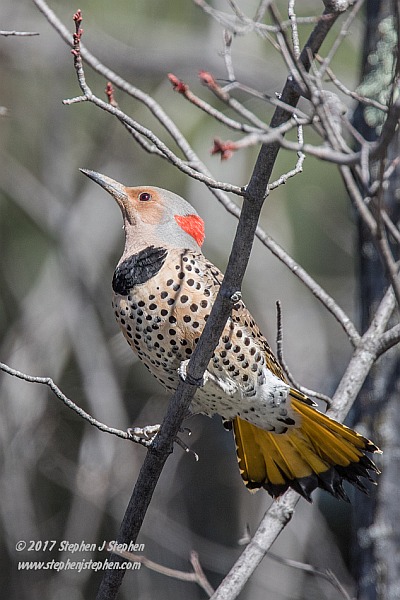
You can view more of my March and April 2017 images by clicking here.
Feb 28, 2017
Well the winter of 2016-2017 has been highly variable weatherwise. We have had plenty of snow and cold temperatures alternating with thawing periods. On this last day of February the large quantity of snow around the region seems to be receding quickly. That being said this is still Canada and we could easily see another big winter storm or two before spring arrives in ernest.
Following our great fall trip to Algonquin Park I was a bit slow getting out to do some local photography. Once I did winter birds and landscapes seemed to be my best photographic subjects as you will see in my latest collection of images. Although I had hoped to see and photograph some winter finches such as Pine Grosbeaks, I had more success with owls including Snowy, Barred and Great Gray Owls. The beautiful Great Gray Owls and Snowies do not show up around Ottawa each winter but rather during 'irruption' years when the numbers of their normal prey species (voles and lemmings) are reduced further north. We had a few Snowy Owls for most of the winter and some Great Grays started appearing around the region in the past few weeks. I hope to be able to create a few more images of Great Grays before they return to their boreal forest home further north.
In addition to owls, some of my other subjects included several of our songbirds the remain with us throughout our long winter period. Blue Jays, Black-Capped Chickadees, White-Breasted Nuthatches and Tree Sparrows are all beautiful birds in their own right.
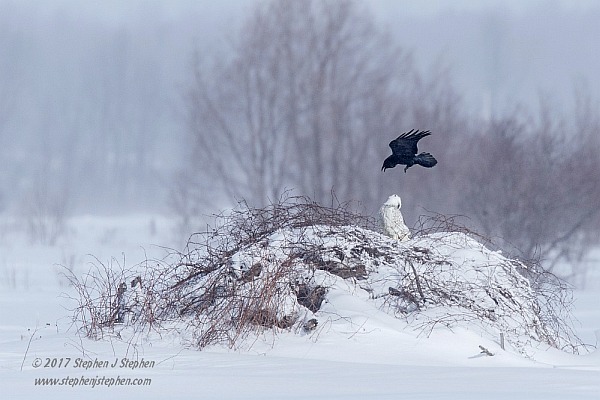
While I like creating close-up and portrait images of my subjects I believe that capturing my subjects exhibiting natural behaviours or interacting with each other can offer the viewer some interesting insights into how these birds and animals live. In the image above you can see a Raven harassing a Snowy Owl that was trying to rest on a rock pile in a farm field. Ravens, American Crows and many other bird species sometimes harass owls, hawks and other birds of prey when they find them in the hope that they will be driven off. This does occur at times but in this instance the Snowy Owl held its ground and just looked up at the Raven. It also stayed put when four American Crows arrived immediately after the Raven. Many birders and photographers have found resting birds of prey through the inadvertent help of other birds swarming the predator.
You can view more of my winter 2016-2017 images by clicking here.
Oct 30, 2016
September and October were both very good months for creating new images this year. Early in September wading birds such as Great Blue and Green Herons and Great Egrets offered many photo opportunities in the west end of Ottawa.
We returned to camp again in Algonquin Provincial Park for 10 days in late September and early October. I was hoping to see moose during the rut (mating season). The moose rut in Algonquin generally begins in last September or early October and lasts approximately 2 weeks. Last year we stayed in the park around the same dates but, despite daily outings, I didn't see a single moose. What a difference a year made. This fall I was extremely successful. In total I saw and photographed 7 moose: 2 Bulls, 3 cows and 3 calves! The most exciting time was when a big bull met up with a cow and her calf. The bull 'tested' her readiness to mate by laying his chin on her rump. She wasn't quite ready but seeing this interesting behavioural interaction was a first for me.
As always there were many other fascinating things to photograph in the park including: birds, plants, mushrooms and fall scenery. I have received an incredible about of positive feedback on the image below which I call "Mist over Costello Creek". It was created by merging three identical images (with different exposures) to cover the bright, medium and dark areas of the image, something a camera sensor, no matter how good, cannot capture in a single image.
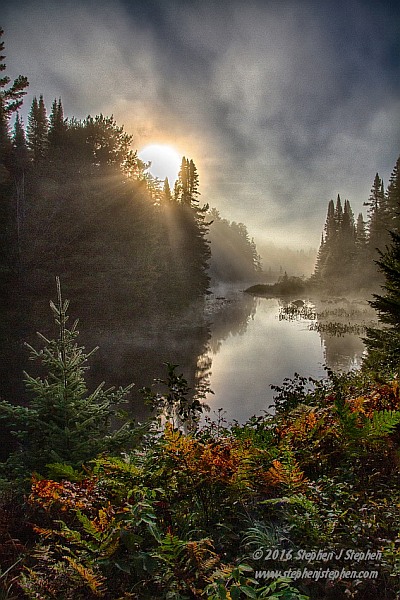
We capped off the wonderful trip to Algonquin by watching a young Peregrine Falcon locked in a life and death struggle with a juvenile gull. It had captured the gull in mid air just above the highway as we were driving past. Experienced Peregrines can normally deliver a stunning or killing blow when they make they diving attack but the young bird did not do that. As a result the two birds "wrestled" for nearly 10 minutes before the Peregrine suddenly, and unexpectedly, broke off its attack. The gull did not look as if it would survive. Nature can be harsh sometimes but it was a very rare event to witness and it's always best not to interfere.
You can view more of my fall 2016 images by clicking here.
Aug 31, 2016
During July and August we took a 5 week trip back to New Brunswick to camp and to visit family and friends. To break up the long drive hauling our trailer we stopped for a couple of days in Rivière-Du-Loup, Québec located on the south shore of the St. Lawrence Estuary. The estuary is one of the great places on Canada's east coast to view many species of whales and sea birds during the summer. This is particularly true where the Saguenay River empties into the St. Lawrence. The area is part of Parks Canada's Saguenay St. Lawrence Marine Park. The park and surrounding region has the most southernly resident poulation of Beluga whales anywhere and we were fortunately enough to see several of these small, white, toothed whales during our whale watching cruise there.
From there we travelled to Charlotte County, New Brunswick and camped in St. Andrews and on Grand Manan Island. We had lived in St. Andrews twice, many years ago, so it is always a treat to go back to re-explore the area.
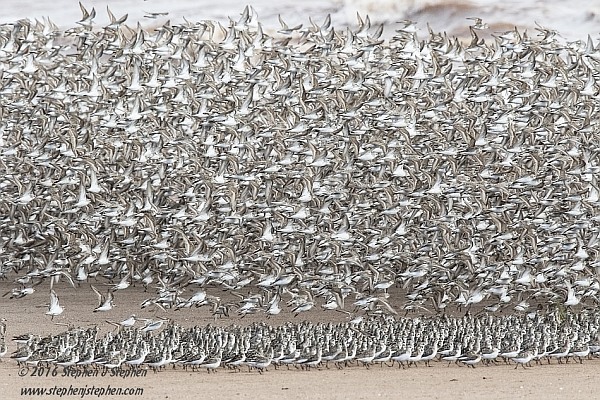
After Charlotte County we visited family and then moved onto Fundy National Park on the Bay of Fundy, near Alma, New Brunswick. I explored the park and nearby St Mary's Point. St. Mary's is within the Shepody National Wildlife Area and part of a larger Hemispheric Shorebird Reserve for the Semipalmated Sandpiper. This species, along with many other shorebirds, use the area as an important feeding and resting place suring sring and fall migrations. Up to 85% of the world's population of this species stops here. To see tens of thousands of these small birds flying by, or landing on the beach (see photo above) en masse is an incredible sight.
Such large numbers of birds attract birds of prey looking for a meal. I saw both a Merlin and a Peregrine Falcon flying over the beach hoping to catch an unlucky migrant. The sight of a predator puts the birds up into the air and they fly in tight formation by the thousands, looking like swirling smoke from a distance, as they try to confuse the hunters. One can experince the same spectacle at Johnson's Mills which is several kilometres away, as the birds fly. This location is closer to Dorchester and Sackville New Brunswick. I visited both beaches during the trip.
I also visited the Sackville Waterfowl Park in the heart of Sackville, New Brunswick. It is a wonderful place to take walks along meandering boardwalks above the marsh and observe waterfowl and shorebirds. It was my first time there but I would love to visit again especially in the spring breeding season.
To more images from our summer 2016 trip please click here.
August 31, 2015
After recovering from all the excitement of our wonderful trip to Namibia, we settled back down into our more normal summer routine back home. The images that I created were fewer but quite varied and included: landscape, reptiles, insects, mammals and birds. We had our first trip to Charleston Lake Provincial Park here in Ontario and many of the photos were created there.
We did take a quite trip back to New Brunswick to visit family and I photographed another lovely waterfall there near Fredericton.
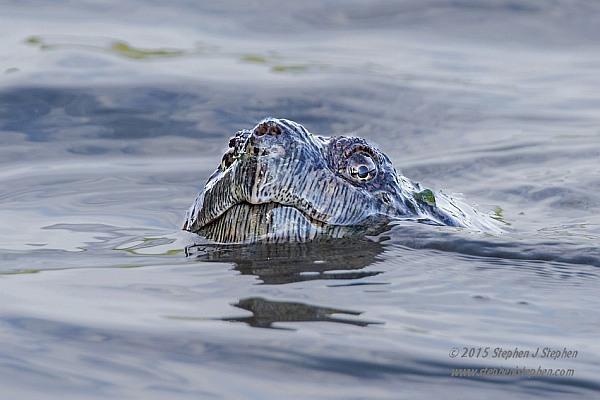
We are looking forward to another fall camping trip to Algonquin Provincial Park in late September and early October. If fortunate, I hope to capture some images of moose during the rut (mating season).
To view some images from the summer please click here.
Jun 30, 2015
Earlier this month we returned from a trip of a lifetime" photo safari to the African country of Namibia. Namibia was formerly German South-West Africa and then South West Africa. The country gained its independence from South Africa in March 1990. We spent a little over 11 wonderful days, in late May and early June, in Etosha (pronounced E-toe-sha} National Park in the northern part of the country. Etosha is a 22,750km² wildlife sanctuary and known worldwide for its great game viewing. Near it's centre is the Etosha Salt Pan some 5000km² of dry calcite. During the rainy season parts of this pan flood and the waters attract thousands of flamingos.
Over the course of our time there we stayed at lovely chalets in 3 different lodges: Okaukuejo, Namutoni and Halali. The lodges were located quite far apart in the central and west parts of the park. Each morning, shortly after sunrise, we would leave a lodge compound and do self-driven day safaris throughout the park observing birds, elephants, giraffe, lions, the endangered Black Rhino and many species of antelope at both natural and man-made waterholes. Wildlife was also often seen along the park's roads while travelling between waterholes. May and June is the start of fall, and the beginning of the dry season, in the park and all manner of wildlife visit the waterholes daily to drink.
One of the important park rules is that all visitors must return to the safety of the lodge compounds before sunset each day. This rule did not interrupt our wildlife viewing as each lodge had a waterhole that was lit up at night. Park visitors could safely observe wildlife coming to drink at these waterholes 24 hours a day. The Okaukuejo and Halali waterholes offered the best nighttime viewing. One could often see up to 7 Black Rhinos at the same time at night at Okaukuejo. Elephants, giraffes, lions, spotted hyaena and many more species also came to drink after sunset. Sunsets and sunrises were spectacular with the sun being surrounded by an incredible orange-red sky.
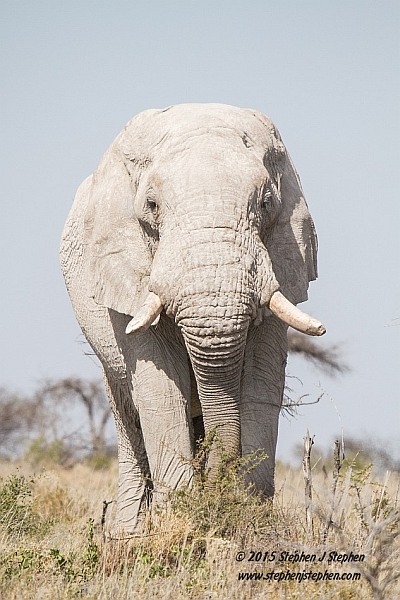
May 29 was perhaps the most memorable day for me, although every day was unique in its own way. On that day we spent 15 wonderful minutes with a handsome male leopard very early one morning at the Kalhhuewel waterhole. It was magical to have him suddenly appear out fo the bush, mark his territory, stop for a drink and then disappear again. Later on in another part of the park we saw a total of 16 lions and lionesses (in two prides) within an hour. Following that we witnessed 300-400 Springbok antelope moving en masses in the direction of a waterhole.
If you ever have the chance to visit Etosha you will love it too!
To view 2 more pages of my Etosha images please click here.
May 31, 2015
I have visited Vancouver Island in British Columbia numerous times over the years while working for Both Fisheries and Oceans Canada and the Canadian Food Inspection Agency. I took the opportunity in late April and early May to finally spend 10 days on the island exploring its scenic and wildlife beauty.
I started my trip in and around Victoria, the provincial capital of the province. Areas like West Saanich and Esquimault offered opporunities to photograph a variety of birdlife along the coastline including: Black Brant Geese, Semi-palmated Plovers, Mew Gulls and Caspian Terns.
From there I moved up the east coast of the island stopping first at Goldstream Provincial Park. Goldstream is a beautiful, primarily wooded, park with Goldstream running through it. In the springtime the forest seems to have a thousand hues of green from the many leaves, ferns and mosses. I had hope to photograph an American Dipper bird, as I had seen one there many years ago, but it was not to be. I was successful though in getting good images of Steller's Jays, River Otter and a male Red-Bellied Sapsucker, the western relative to the eastern species, the Yellow-Bellied Sapsucker.
From there I moved up to Nanaimo and spent several days there visiting coastal locations such as Pipers Lagoon Park, Rathtrevor Provincial Park (Parksville) and the shoreline near the community of Qualicum Beach. As usual Bald Eagles were plentiful and I had several good opportunities to photograph Black Oystercatchers and California Sea Lions as well.
From the Nanaimo area I took a long drive over to Tofino on the west coast of the Island. The drive through the mountains was incredibly scenic and the views were often breathtaking but there oare few places to safely pull over and create images. I had never been to Tofino before but had always heard about its beautiful beaches and the waves of the wide Pacific. I was hoping that my timing would be right as the spring shorebird migration normally begins in late April and early May. While there were a number of shorebirds including some Western Sandpipers, a new species for me, the migration was only beginning. My schedule permitted only about 36 hours in the area before I had to return to Nanaimo to rendevous with my good friend Simon Jones who is also a pilot.
Simon had previously invited me several times to come flying with him if I ever got back to the island so this time I was happily able to accept his offer. While driving to Tofino was enjoyable, flying over the mountains and viewing the stunning scenery from the air was wonderful. Our route took us from the Parksville Qualicum airport across the island to Ucluelet, up to Tofino and Nootka Sound then back over the mountains to Courtney Airport and finally Parksville Qualicum again. An incredible flight that I would love to do again!
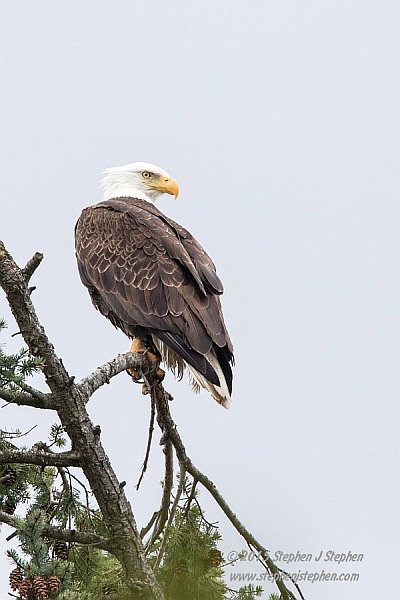
From there I spent several days staying with friends on their farm near Ladysmith which is south of Nanaimo. The farm offered different opportunities for more bird species such as California Quail, Spotted Towhee and a very special bird: a Barn Owl on a nearby farm. The Barn Owl was a life list addition for me as was the Golden-Crowned Sparrows. On my very last full day in the Nanaimo area I met up with friends at teh Deep Bay harbour and we sailed out into Baynes Sound. We visited Norris Rocks and saw Steller and California Sea Lions, more Bald Eagles, Harlequin Ducks and Pacific Loons. All in all it was a very rewarding trip and I hope to go back again someday.
To view two pages of my images from Vancouver Island please click here.
October 31, 2014
Well fall is upon us. The leaves are changing and farm harvest is almost over. In September I had the opportunity to observe a friend as he harvested honey from his bee hives. I had always wanted to photograph this activity and his invitation gave me the chance to do it first hand. The bees were very calm and cooperative after the smoker was applied but I know that this is no always the case. I was able to get fairly close to the action without once being stung.
Also in September I photographed a tiny Wood Frog in our back garden. It was a first for me but hopefully not the last. Then it was back to Algonquin Park for a few days of fall camping at the Lake of Two Rivers campground. I had never camped in the park in the fall nor had I stayed at Lake of Two Rivers. It was a very enjoyable time with cooler daytime temperatures and virtually no biting insects. There is something magical to be sitting around a campfire at night listening to wolves howl.
Although there were a lot of visitors who had come to see the fall colours, I had plenty of time to just enjoy the scenery and wildlife. I even met several of my photography friends and we spent some time together looking for subjects to photograph. I had hoped to photograph some moose during the fall rut but, like most people there, we came up empty-handed. I was able to photograph a male Black-Backed Woodpecker, a handsome Red Fox, Gray Jays, several Spruce Grouse and a majestic Great Gray Owl.
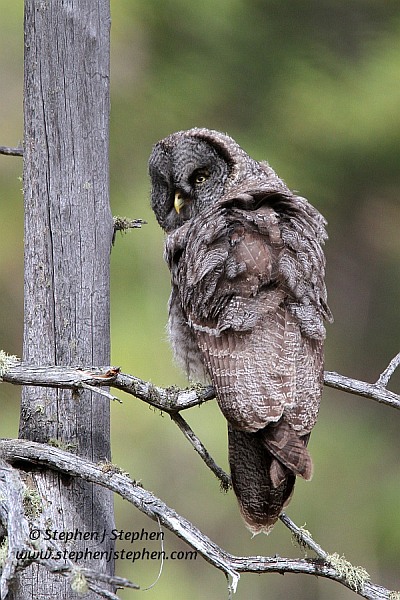
To view more of my fall 2014 images please click here.
All photographs are copyright of Stephen J Stephen.
Permission is required to use any photograph on this website.